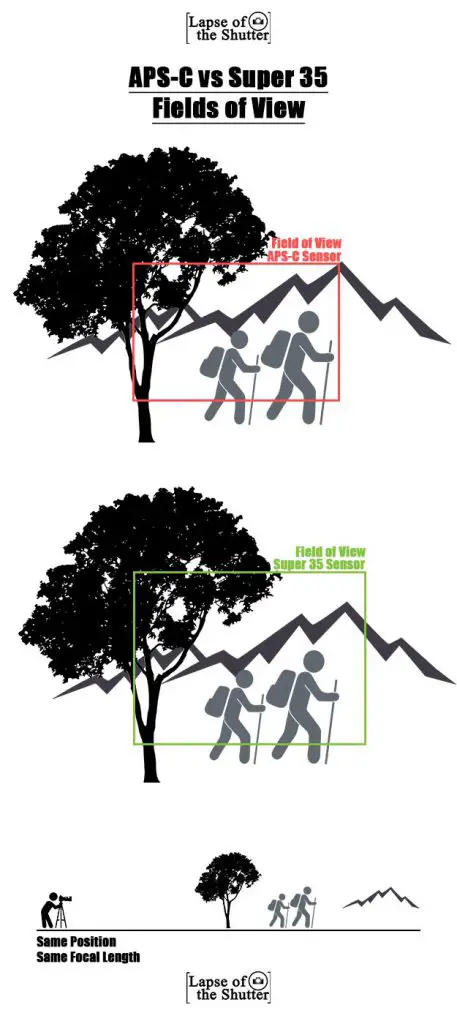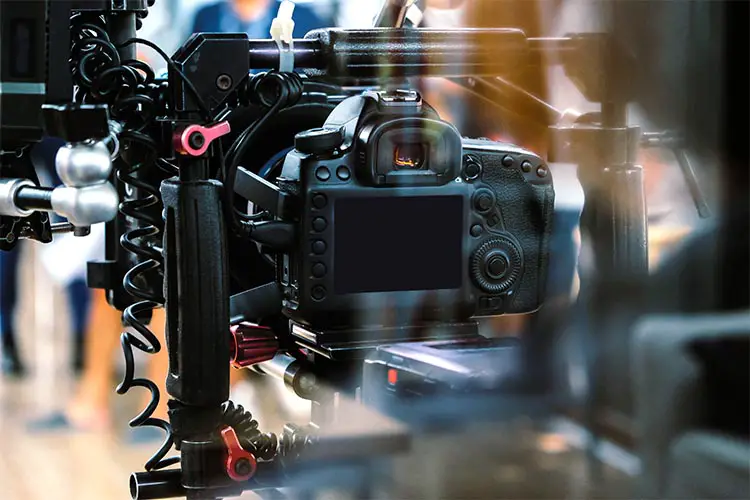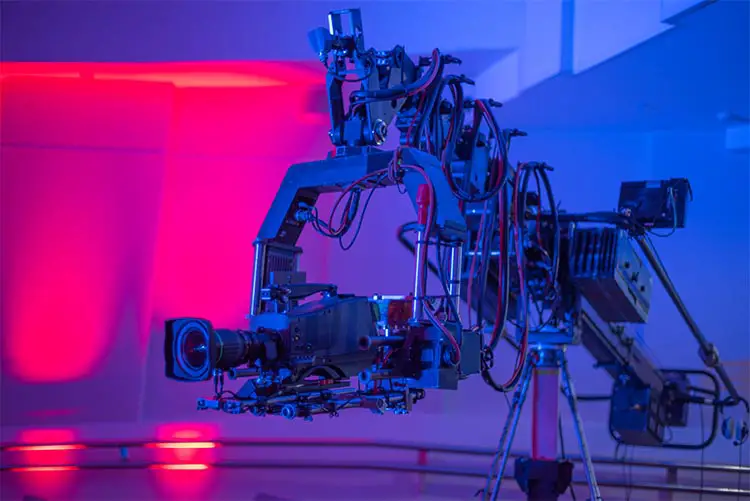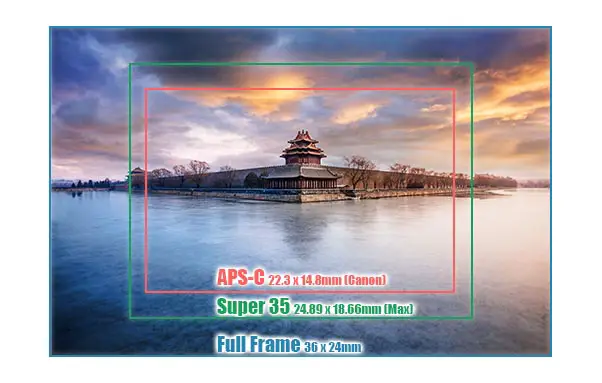If you don’t have time to read this article in full, then the difference between APS-C vs Super 35 is that APS-C is a better format for stills photography, while Super 35 is well suited to videography as you can pull pretty much any aspect ratio from it.
If you are intending to get a camera for filmmaking, then cameras with the Super 35 sensor like those from Blackmagic will inevitably find themselves in front of you.
But APS-C is a much more popular format, and appears to be almost identical to Super 35 in many ways. So why is Super 35 so popular amongst filmmakers?
This article covers the differences between Super 35 vs APS-C, and looks at the pros and cons of each so that you can be assured of making the right choice of camera for you.
What is a Super 35 vs APS-C sensor?
A lot of the differences between a Super 35 vs. APS-C sensor have to do with the features offered and the intended purpose. Generally, Super 35 sensors are focused on video capture while APS-C sensors are focused on still images.
Super 35 Sensor Origins
Super 35 originally referred to a range of similarly sized film formats that offered more image area on the same size stock as standard 35mm movie film. The formats were also easier and usually less expensive to work with.
Super 35’s maximum size on film was 24.89 mm wide by 18.66 mm tall. The exact dimensions depend on aspect ratio as well as camera and lens choices.
Super 35 sensors are generally featured on cameras that focus on video production.
Super 35 Sensor Size and resolution
As with the film, the exact size of a Super 35 sensor varies. The resolution, too, can be quite different.
The Canon EOS C100 Mark II Cinema EOS Camera has a sensor size of 24.6 x 13.8 mm and captures 1080p video from an 8.9 megapixel sensor. The Canon EOS C70 Cinema Camera, on the other hand, uses an updated version of the same size and resolution sensor. It captures 4K 60p video, however.
Another camera, the Z CAM E2-S6 Super 35 6K Cinema Camera, uses a 23.4 x 15.67 mm sensor that has a resolution of 26 megapixels and captures 6K video. Another 6K offering is the Blackmagic Design Pocket Cinema Camera 6K which has a 23.1 x 12.99 mm sensor with a resolution of 21.2 megapixels and 6K video capture.

APS-C Sensor Origins
In the early days of digital cameras, a sensor the size of a 35mm still frame — 36 x 24 mm — was nearly impossible. Instead, the first interchangeable lens digital cameras used a sensor close to the size of a 1990s film format, Advanced Photo System or APS.
APS-C Sensor Size and Resolution
The original APS film was 25.1×16.7 mm, but there are some variants in APS-C sensor size. Canon settled on 22.3 x 14.8 mm, while most other manufacturers went with 23.5 x 15.6 mm.
Both sensor sizes are offered with a variety of still and video resolutions, usually topping out between 20 and 30 megapixels for images and 4K for video.
The Nikon Zfc uses a 20.9 megapixel sensor that’s 23.5 x 15.6 mm and can capture 4K 30p video. The FUJIFILM X-T4 Mirrorless Camera has a sensor the same size but offering a 26.1 megapixel resolution and it shoots 4K 60p video.
The highest resolution available in an APS-C camera is in the Fujifilm X-H2, which shoots 40.2 megapixel images on a 22.3 x 15.6 mm sensor and can capture 8K 30p video.
APS-C vs Super 35 Differences
Much of the difference between the two sensors comes down to form factor and focus.
The big clue on what to expect comes from the origin of both names. APS-C sensors are primarily focused on still photography, though many cameras with APS-C sensors offer excellent video capabilities.
Super 35 sensors are exclusively found on digital cinema cameras — cameras primarily used to capture video, though many can capture high resolution stills as well.
Form factor
Most APS-C sensor cameras show off their photography focus with a mode dial, grip and electronic or optical viewfinder. Some make recording video as easy as hitting a single button, while others require the camera to be in a specific mode.

Super 35 sensor cameras have a range of form factors, but almost all are modular, allowing easy attachment of larger screens and other accessories. Most offer button arrangements quite different from the photography focused APS-C cameras.
This makes holding the cameras steady, to take one example, quite different.
Video cameras must stay steady for longer than a stills camera, making them much harder to hand hold. Instead, they usually offer easy mounting to a variety of tripods, gimbals or handheld shoulder rigs.
Stills-focused cameras can be tripod mounted, but are designed to be carried from the shoulder and held in two hands.
Lenses
There are three main lens mounts available on Super 35 cameras today, Canon EF, Canon RF and PL. PL has long been a cinema industry standard, while Canon EF is among the most popular lens mounts and has a wide variety of lenses available.
Canon RF is the company’s new mirrorless mount, and both the Canon C70 mentioned earlier and the RED DIGITAL CINEMA KOMODO 6K Digital Cinema Camera use that. The RED uses a 19.9 megapixel, 27.03 x 14.26 mm sensor that records 6K video.

Super 35 and APS-C Similarities
Because the sensors are almost identically sized, even with their different origins, some things are the same between them. One thing is their relationship to full-frame cameras and 35mm stills.
Both APS-C and Super 35 sensors have a so-called “crop factor” of 1.5x or 1.6x. That refers to the different fields of view the sensors offer compared to full frame 35mm.
Because they are physically smaller, they offer a narrower field of view, making lenses effectively 1.5x or 1.6x narrower than they are on a full-frame camera.
For movie making, this is essentially the same as it was when using Super 35 film, while it requires more adjustment from a photography perspective.

APS-C vs Super 35 Pros and Cons
Many of the pros and cons of both sensor types come down to the intended use. When choosing between a Super 35 vs APS-C sensor, you need to think about whether you want a camera focused on stills or video and choose accordingly.
APS-C Pros
- Still image resolution up to 32.5 megapixels
- Multiple lens mounts and brands available
- More affordable
APS-C Cons
- Video limited to 4K or lower resolution
- Form factor makes video more challenging
- Quality of video often limited
Super 35 Pros
- Video resolution up to 6K available
- Easier to mount to tripod or other rig
- Modular design makes adding accessories easy
Super 35 Cons
- Often have no viewfinder, making composing photos harder
- Native 4K sensors limited to about 9 megapixel stills
- Limited lens mount options without needing adapters
Read More:






4 Responses
Dan C
Excellent article!
And thank you for sharing this knowledge with us, it is greatly appreciated.
One small tidbit is on updating the article to feature the Fuji X-H2, which now has the highest resolution of all APS-C cameras at 40 megapixels.
I’m sure Canon is going to try and top this.
But for the time being, the Fuji X-H2 is the king of APS-C sensors!
Again, I thank you for this incredibly informative article sir!
Tim Daniels
Thanks for the tip, Dan!
James
There are cameras with APS-C sensors (or even smaller ones like Micro FourThirds) that can record videos at higher than 4k resolution.
Tim Daniels
Thanks, James. You are right – these have come out since the post was written.